
Historic England is asking people “what do you love about your local high street?” as the first part of a national conversation and Watford’s MP Dean Russell is encouraging local residents to get involved.
From 20th – 26th September, Historic England is asking people to share what they love about their local high street on social media. Whether it’s the memory of the place you bought your first ever album, a shop that’s become part of your weekend routine, or a place you go to meet friends and family, Historic England wants to hear about it. Those stories will come together to build a national picture of what makes high streets so special and to learn what matters most when it comes to their future.
Historic England commissioned a study with revealed that 73% of people said their local high street is important to them, 92% of people care what their high street looks like and 90% agree that it’s worth trying to save historic features when trying to improve local places.
Historic England will be seeking to find out what people value about their high street and their hopes for its future. Having crowdsourced this information, a programme of discussions and commissions will be created to further explore what high streets could be and look like in the future, all with the aim of empowering people to take action for their local high street.
Dean Russell said: “What I love most about Watford High Street is the many small independent retailers that it has. Whether it be Gibson’s Butchers, Situls or Jackson’s Jewellers, Watford High Street is a great place to go to support our town’s many small businesses. Let’s make sure that Historic England hears from Watford by everyone taking a few minutes to get involved in this important project. You can take part by uploading your own photo to Twitter and tagging @HistoricEngland.”
Duncan Wilson, Chief Executive of Historic England, said “Throughout history high streets have been our gathering places; centres of commerce, conversation and community. They help make where we live unique and special. Nearly half of all high streets were built before 1919. They are one of the most visited and enjoyed types of heritage in the country, a connection to our past and a key to our future. We know they are struggling, and their future is uncertain, and we think this is a timely moment to ask people about their future and consider the part we can all play in supporting these important places.”


